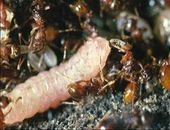
© Jeremy ThomasCaterpillar inside a red ant nest, being fed regurgitations by a worker ant.
Though they wouldn't win much applause at a karaoke lounge, the infant forms of blue butterflies can belt out a convincing cover version of a tune favoured by red ants - which show their appreciation by protecting and feeding the butterfly larvae.
Researchers have found that the larvae and pupae of Maculinea rebeli - a parasitic butterfly native to western Europe, though threatened with extinction - impersonate red ants so faithfully that worker ants worship them as if they were queens, caring for the developing caterpillar even at the expense of their own lives.
"They appeared to be treating the caterpillars as if they were the holiest of holiest, the pinnacle of power, the queen ant," says Jeremy Thomas, an entomologist at the University of Oxford who led the new study.
Playing queenAs young caterpillars,
M. rebeli spend their days gorging on leafy greens. When they're nearly ready to begin their transformation into a butterfly, the caterpillars descend to the forest floor and secrete ant-like chemicals. Duped worker ants ferry the caterpillar to its colony, where it is accepted as another ant, based on its smell alone.
But Thomas noticed that the interlopers seem to get particularly special treatment. When he disturbed a laboratory colony, workers sacrificed their own kin to save the butterfly larvae - much as they would if a queen ant were threatened. "There must be some form of communication by the butterflies that make the ants think they're royal, and at the same time we were pretty damn sure they weren't by chemicals," he says.
Puzzled, his team wondered whether a mysterious ticking sound emitted by blue butterfly larvae and pupae could explain this privileged treatment. The ants produce a song of their own, with subtle differences between queen and worker.
Using miniature microphones hooked up to an MP3 recorder, Thomas' team captured the tunes made by queen and worker ants, as well as by the butterfly larvae and pupae. Auditory analysis showed similarities in key acoustic features of the ant and butterfly sounds, such as resonant frequency.
Ant attractionThe researchers then used Lilliputian speakers to audition the various songs to workers. When they listened to their own songs, the workers perked up. "Instead of running away or acting with aggression, the speakers attracted the worker ants to them and they tapped them with their antennae with great interest," says Thomas.
The recording of a queen's song inspired even more interest. Workers surrounded the speaker and refused to budge. Amazingly, Thomas' team observed nearly the same behaviour when they played the butterfly songs to the ants - suggesting that auditory mimicry is the key to the butterflies' ascendancy.
"This use of sound potentially solves the mystery of how they mimic the queen even though they don't smell like the queen," says David Nash, an entomologist at the University of Copenhagen. "In hindsight, the results are so consistent and logical," agrees Josef Settele, at the Helmholtz Centre for Environmental Research in Halle, Germany.
Other species of blue butterfly use sound to foster a more equitable relationship with ants, and parasitic ants probably adapted these tunes for their own nefarious purposes, Thomas theorises. But why haven't the ants evolved new chemicals and sounds, rendering them indifferent to the imposters' smells and songs?
Researchers previously assumed that ants have little incentive to do this, because butterflies plague only a small proportion of ant colonies. But Nash's lab recently
found that a related species of ant has done just that with its chemicals. No evidence yet exists for sound wars, but Thomas will be on the lookout.
"There may well be an arms race going on," he says.
Journal reference:
Science, DOI: 10.1126/science.1163583
Reader Comments
to our Newsletter